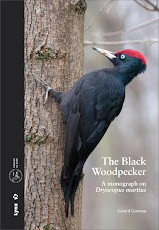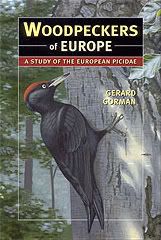HBW and BirdLife International Illustrated Checklist of the Birds of the World. Volume 1: Non-passerines. Del Hoyo, J. & Collar, with David A. Christie, Andrew Elliot & Lincoln D. C. Fishpool.
Published by Lynx Edicions, Barcelona, Spain, August 2014. Publisher's price 145 Euros. Hardback, 904 pages. ISBN 978-84-96553-94-1.
With 357 colour plates, 8290 bird illustrations, range maps for all species and a bibliography of over 2000 references, this new bird checklist is an impressive work. It differs from previous lists in several ways, in particular in its inclusion of colour plates and distribution maps, and is thus the most colourful bird checklist ever produced. Most of the artwork is taken from the HBW series, with new paintings added where needed and some improved. Although first and foremost a checklist, this work might be viewed by some readers as simply an updated and concise edition of the non-passerine volumes of HBW, but the texts are more detailed than in a typical checklist, yet much more concise than in HBW, and the taxonomy is very different.
The taxonomic basis of this checklist is the so-called Biological Species Concept (BSC), which uses a flexible system of scoring based on morphological, vocal, ecological and geographical relationships, now known as the 'Tobias criteria', to indicate species. For more on this approach, see J.A. Tobias, N. Seddon, C.N. Spottiswoode, J.D. Pilgrim, L.D.C. Fishpool & N.J. Collar (2010). Quantitative criteria for species delimitation. Ibis. 152. Here, this method has resulted in much re-shuffling (lumping and splitting) by the authors of those taxons described in Lynx's own HBW series. There are 4372 extant species described in this volume of non-passerines, based on 21 'lumps', and 462 'splits', when compared with the taxonomy used in HBW, and compared to previous lists the species level has risen by around 10%. The taxonomic issues involved are outlined in a long and careful introduction where it might come as a surprise to some to find that often quoted, but not always clearly understood, DNA based taxonomic systems are not foremost, although they are taken into account. A key issue raised by this work's taxonomic system is conservation. For example, it becomes clear that regions such as the Philippines, the island of Java and Para State in Amazonian Brazil, are hotspots of species diversity, with many taxons under great pressure and threat, and hence these places, and the fauna found there, should be given prompt conservation priority.
This volume covers the non-passerines and begins with the Ostriches and ends with the Parrots. As author of the recently published Woodpeckers of the World (Helm 2014), I immediately found myself examining pages 646 to 688 of this list, where the Picidae (woodpeckers) are covered in 254 'species'. This figure compares to 239 in Woodpeckers of the World, however this does not simply amount to 15 more 'species' as several which were lumped in my book have been split here (e.g. Dendrocopos leucotos owstoni to Amani Woodpecker Dendrocopos owstoni and Colaptes campestris campestroides to Pampas Flicker Colaptes campestroides), and others lumped (e.g. American & Eurasian Three-toed Woodpeckers and Golden-fronted & Velasquez's Woodpeckers). If the total number of 'species' in the two works are combined, a grand total of 261 results (which makes my already daunting task of finding all of the world's picids even more difficult!).
This work is a triumph of research, editing and writing, and I am reluctant to find fault, however it is usual to do just that in a review, so here is my main gripe! In several instances, I found the use of English names uncomfortable, if not controversial. It seems that a standardisation of English vernacular bird names is still not on the horizon and this work does not really help in that regard. Clearly, when a new species is described, or results from a split, a new name needs to be found and here the authors generally approach this sensibly, although there is a lack of consistency. For example, the established name for Picus vaillantii is Levaillant's Woodpecker, but this is changed to Mahgreb Green Woodpecker (presumably to remove Mr Levaillant's name), but that of Kaempfer's Woodpecker, for example, is not. In addition, in the case of Dendropicos elliotii, the existing name Elliot's Woodpecker is not only retained, but Johnston's Woodpecker adopted for the split of its (former) johnstonii race to full species. Surely the authors had enough to do in finding and agreeing upon new names for new species without having to re-name existing ones?
Obviously in a vast undertaking of this kind, some oversights are inevitable, and for future editions/up-dates, it might be noted that the distribution of Arrowhead Piculet Picumnus minutissimus is said to be 'from Guyana E to French Guiana' (and the range map reflects this), however there are actually no confirmed records of this taxon from outside Surinam.
So, do you need this huge and not inexpensive checklist ? Well, even if you already have the HBW series, even if you are uncomfortable with the taxonomic system used or the creation of some English names, the answer simply has to be YES. This list is now a benchmark, a reference that is hard to ignored and which may (when Volume 2, the Passerines, is released in 2016) become the definitive checklist for birds. All in all, the authors, editors, designers and the publisher are to be congratulated.
Gerard Gorman.






